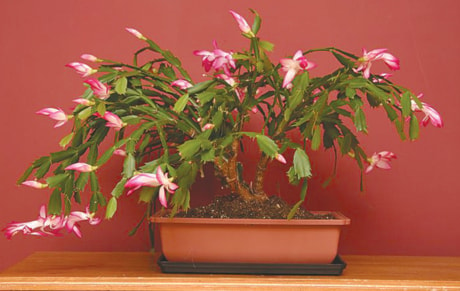Confusion and misinformation abounds when it comes to Christmas Cacti.
One reason for the confusion is that Christmas cacti, Thanksgiving cacti and Easter cacti are all very similar in flower, shape and growth habits. Each variety has its own natural blooming time but this can be manipulated by controlling the hours of sunlight and darkness the plant receives.
Christmas cacti (Schlumbergera bridgesii) have pointed, lobed segments. The plants start blooming in December, close to Christmas.
Thanksgiving cacti (Schlumbergera truncate) have smooth segments without points. This variety will bloom between October and Christmas.
Easter Cacti (Rhipsalidopsis gaertneri) have wider, rounder segments.
These plants bloom profusely in the spring and can have a scattering of flowers at other times of the year.
Hybridizing between the three varieties has lead to further confusion. All the cacti in the group are also known as “Holiday Cacti”
While all the plants have interesting foliage, the plants are sold primarily for their flowers which come in a variety of pink, purple, red, orange and cream.
Thanksgiving and Christmas cacti start producing buds when the daylight hours decrease in the fall. Easter cacti will produce a few buds in the fall but the majority are formed after the New Year when the daylight hours start to increase, but are still much shorter than the hours of darkness.
Greenhouses use shade cloth to ensure blooms but it is easy to bring these plants into bud.
Place then in a room that is rarely used in the evening to ensure that they will not receive artificial light. Plants in darker areas of a room have been known to bloom on one side but not the other due to the amount of artificial light received.
While Holiday Cacti are true cacti they would perish in desert like conditions. They are native to the rainforest and should be treated similar to tropical plants. They do well in bright indirect sunlight.
Do not place them in a south or east facing window.
Water the plants when the top portion of the sold is dry. Plants that are under watered wilt, and flop over the rim of the pot. Plants that receive too much moisture look similar to wilted ones.
Fertilize the plants when they are actively growing or blooming.
Unlike most tropical plants Holiday Cacti do not go dormant in the fall but begin to produce buds and flower.
Holiday Cacti propagate easily. Each segment will make a new plant.
Break off plant segments and place them, bottom down in sterilized potting soil. Cover the pot with plastic or a glass jar to help keep the soil moist and the air humid. There should be a small opening in the cover to allow air to circulate. Roots will be evident in three to four weeks.
Once the segments have grown a small root system they can be placed in pots. Plant a number of rooted segments in each pot to ensure the finished product will grow into a full plant and be pleasing to the eye. It is up to the individual whether to plant all one colour or variety in a container or make a mixed container.
Young plants will grow upright but as the stems become longer their weight will pull them downwards. Eventually the plant will cascade over the pot. With proper care, Holiday Cacti can live for over 20 years, each year producing a multitude of blooms.
Linda Tomlinson is a horticulturist and educator living in Rocky Mountain House. You can contact her at your_garden@hotmail.com
